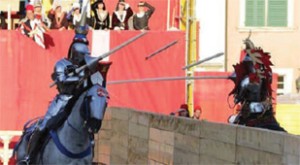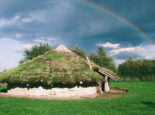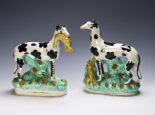The Joust of St Peter
The Joust of St Peter 1 2
[prev] …knights mounting their horses from the ground all the time,’ says Dominic. He and his colleagues do sometimes use mounting blocks, but that’s more for the horse’s sake than the rider’s.
Dominic’s own armour – or ‘harness’ as it’s known in the trade – is based on an example from 1462. The original was made in Milan, captured during battle, and is now known as ‘Le Landeron’ after the place in Switzerland where it ended up. Close to, you see that Dominic’s version is also beautifully decorated. ‘I’ve customised it to my own specifications, rather than it being an exact copy. So, if you look at the pointillé work, you’ll see various words and designs that apply specifically to me.’ It was common at the time to include prayers amongst the decorations, but it wasn’t always so lofty. It turns out that the Latin written on the culet, for example (the plates at the back just above the seat) actually says ‘buttocks’.
‘There were lots of these kinds of jokes written into armour,’ says Dominic. ‘But if you were spending the equivalent of £40,000 on it, you could have it how you liked!’ It took around a year for a full harness to be made, and when completed it was an incredibly elaborate piece of engineering. The comparison with a high performance car is not inappropriate – and they could even come with optional extras. ‘This is field armour, but there are different pieces that can be swapped in for mêlées, jousts – different pieces that tailor it to what I want to do, mostly fighting on horseback.’
I ask Dominic about what goes through his mind in the moments before the joust. ‘You need to put yourself in the mindset of any sportsman at a high level. You’re intent upon defeating your opponent, and in order to do that you need to be in the right frame of mind, and you and your horse have to be working together. It’s a team sport, too – we often relate it to Formula One with the pit crew.’ He turns towards the trailer where the horses are being prepared. ‘My pit crew is working away right now! For them, it’s important to make sure everything’s right with the horse, that the equipment is correct. All that leads to the point where I take a lance in my hand, I signal to my opponent, and we charge at each other. This called the encounter – and that collision where we splinter lances is where we decide who has won and who has lost.’
‘You’re a legitimate target, and it’s regarded as cowardice to duck out of the way’
Perhaps unexpectedly, jousting uses a points system, and there are judges either side of the tiltyard spotting and scoring each strike. This makes it sound all rather civilised – until one learns how the highest points are scored. ‘In the actual encounter, all my focus is on where I strike the opponent, whether it’s on the shield – which is a safe bet – or the body, or the helmet. That will gain me more points.’ Yes, that’s right – for maximum points your opponent will be aiming his lance point at your head. ‘It’s like cricket,’ says Dominic. ‘You can steadily accrue points, but the drama happens when one decides to go for the big six and strikes the helmet, putting himself ahead. Then the pressure is on the other to do the same.’ I get Dominic’s cricketing analogy, although this is more like a game in which your opponent is coming at you wielding the bat at your face. On a galloping horse. ‘This is where the martial art comes in. You must be very Zen-like – calm, collected.’ This involves having ‘total disregard’ for where the opponent’s lance is going. ‘You’re a legitimate target, and it’s regarded as cowardice to duck out of the way. And anyway, if you were watching his lance, you’d blink – and that would be fatal.’
The ground will shake. The crowd will roar. Lances will be shattered. Whoever you are cheering for on the day, it promises to be a truly awesome experience
There were many different types of joust during this period, the main ones in England being Jousts of Peace and Jousts of War. The latter were à l’outrance, which meant they used sharpened lances. The Joust of St Peter, however, is the friendlier version: à plaisance, with blunted lances. ‘That disperses the blow,’ explains Dominic, ‘so it’s like a hammer rather than a point. Fewer people are injured that way, but it remains a very dangerous sport, which must be carried out with correct equipment, worn correctly. It’s our responsibility, as professional riders, to make sure that we are as knowledgeable as possible, and that our equipment is as correct as possible. And being correct means being historically accurate.’ We use the phrase ‘once in a lifetime experience’ rather too freely these days, but the Joust of St Peter surely qualifies. The ground will shake. The crowd will roar. Lances will be shattered. Whoever you are cheering for on the day, it promises to be a truly awesome experience. Just remember not to blink…
The Joust of St Peter on 20 and 21 June, part of the Peterborough Heritage Festival.
www.vivacity-peterborough.com
The Joust of St Peter 1 2
















